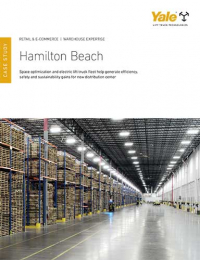United States’ business growth environment dips
Grant Thornton Global Dynamism Index ranks countries based on 22 indicators.
Latest Material Handling News
Lucas Watson appointed CSO for Körber’s Parcel Logistics business in North America Hyster recognizes Dealers of Distinction for 2023 Carolina Handling names Joe Perkins as COO Walmart deploying autonomous lift trucks at four of its high-tech DCs Kathleen Phelps to join FORTNA as chief financial officer More NewsThe U.S. business environment ranks as the 11th in the world for dynamic growing businesses, according to the Grant Thornton Global Dynamism Index. The United States, down one spot from 10th in last year’s index, sits ahead of Japan, Germany and France.
“Encouragingly, U.S. business growth fundamentals are improving, particularly in the areas of science and technology, operating environment, and economic expansion,” said Stephen Chipman, chief executive officer of Grant Thornton. “However, there continues to be a perception of an increasingly difficult U.S. financing environment, with this year’s respondents citing private sector debt, corporate tax burden, and a decline in inward investment growth as the factors weighing us down.”
Taking the lead is Australia, which performs consistently across all five categories of dynamism, climbing seven places in 2013 largely due to relative improvements in labor productivity and real GDP growth. China leaped 17 spots to rank third overall and its improvements in labor and human capital and economics and growth led to its taking the first and second spots respectively in those categories. China also saw major improvement from last year in science and technology, rising eight places to rank 14 as the result of increased research and development spending.
China pulled away from its BRIC counterparts in 2013. The index reveals that while the Chinese economy has significantly improved its attractiveness as a place to do business during the last 12 months, Russia, India and Brazil have fallen away and face significant challenges.
The rankings indicate which economies have the most dynamic business growth environments, where dynamism refers to the changes in an economy that are likely to lead to a faster future rate of growth.
Overall Rankings
1. Australia 66.5
2. Chile 64.5
3. China 62.7
4. New Zealand 62.6
5. Canada 62.3 (Tied)
5. Finland 62.3 (Tied)
7. Singapore 61.9
8. Israel 61.8
9. Sweden 61.6
10. Norway 60.9
United States Rank: 11th (60.5)
For a complete list of 50 countries, click here.
A. Business operating environment
(Foreign trade and exchange regimes and controls; policy towards private enterprise and competition; political stability; and legal and regulatory risk)
1. Ireland 92.5
2. Canada 92.0
3. Sweden 91.9
4. Netherlands 91.8
5. Finland 91.7
6. Australia 91.1
7. Denmark 91.0
8. Luxembourg 90.4
9. Austria 89.8 (Tied)
9. Singapore 89.8 (Tied)
United States Rank: 12th (89.0)
B. Science and technology
(Broadband subscriber lines per 100 inhabitants; growth in broadband subscriber lines; R&D as % of GDP; total IT spending growth)
1. South Korea 64.2
2. Israel 62.7
3. Finland 62.6
4. Sweden 58.8
5. Japan 58.7
6. Taiwan 55.3
7. Denmark 54.3
8. United States 53.6
9. Switzerland 53.1
10. Germany 49.9
C. Labor and human capital
(Labor productivity growth; unemployment; school life expectancy; % of population under 30)
1. China 75.3
2. Australia 72.4
3. Thailand 69.8
4. Indonesia 69.3
5. Philippines 67.9
6. Venezuela 66.5
7. Uruguay 66.0
8. Chile 64.8
9. New Zealand 63.9
10. Peru 63.7
United States Rank: 21st (54.8)
D. Financing environment
(Quality of overall financial regulatory system; access of firms to medium-term capital; growth in value of inward M&A deals; value of inward M&A deals; private sector credit as % of GDP; inward direct investment growth; corporate tax burden)
1. Singapore 82.2
2. Canada 75.1
3. Chile 71.1
4. Slovenia 70.8
5. Poland 69.8
6. Finland 68.6
7. United Arab Emirates 67.0
8. New Zealand 64.8
9. Israel 63.5
10. Czech Republic 62.9
United States Rank: 28th (51.2)
E. Economics and growth
(Real GDP growth; private consumption per head growth; change in $ value of stock market index)
1. Venezuela 89.8
2. China 89.3
3. Nigeria 80.3
4. Peru 80.0 (Tied)
4. Philippines 80.0 (Tied)
6. Thailand 77.1
7. Vietnam 74.8
8. Malaysia 73.4
9. Saudi Arabia 73.3
10. Indonesia 72.8
United States Rank: 26th (54.0)
The index is compiled of five areas that are identified as key drivers to an economy’s dynamism: business operating environment, science and technology, labor and human capital, economics and growth and the financing environment. Within these groups, there were 22 key data points that were analyzed. More than 400 senior executives from a broad range of countries and industries were then interviewed to determine which aspects of these attributes they deemed most important for business growth. This allowed for the weighting of each aspect according to its perceived relevance.

Article Topics
Latest in Materials Handling
Lucas Watson appointed CSO for Körber’s Parcel Logistics business in North America Hyster recognizes Dealers of Distinction for 2023 Carolina Handling names Joe Perkins as COO C-suite Interview with Keith Moore, CEO, AutoScheduler.AI: MODEX was a meeting place for innovation Walmart deploying autonomous lift trucks at four of its high-tech DCs Coles shops big for automation Kathleen Phelps to join FORTNA as chief financial officer More Materials HandlingSubscribe to Materials Handling Magazine

Find out what the world's most innovative companies are doing to improve productivity in their plants and distribution centers.
Start your FREE subscription today.
April 2024 Modern Materials Handling

Latest Resources










